I always enjoy photographing Vaisakhi celebrations. They are colourful and the Sikhs always welcome people taking an interest in them, and are very open to being photographed. So although I think I’ve probably photographed enough over the years I find it hard not to go and photograph another. Although the events follow a similar pattern, every Gurdwara does things a little differently and I’ve tried not to return to the same places too often to get a little variety.
Of course like all religious festivals you need to behave with suitable respect, and that means wearing a suitable head-covering (I keep a suitable head scarf in my camera bag in April, given to me on one of my first visits to a Gurdwara – though these are normally available at the entrance to most Gurdwaras) and I make sure I wear a decent pair of socks without holes for when I take my shoes off inside the Gurdwara. Occasionally you need to take off shoes on the street, and I wear a pair that will fit in my camera bag in place of my cameras – which will be round my neck.
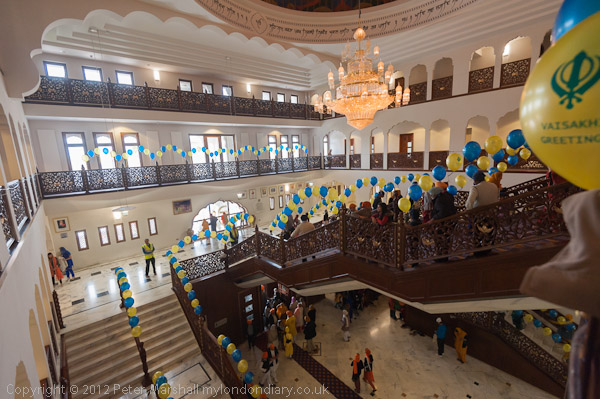
This was the first time I’d been to the Gurdwara at Gravesend, although I’ve photographed around the area – a little under 30 miles east of central London on the Thames, and taken the ferry across from here to Tilbury, the site of London’s remaining docks. Gravesend is the major town in the area and has a large Sikh population, with perhaps 5000 people coming to Vaisakhi from across Kent and south-east London. There has been a Gurdwara in Gravesend since 1956, but the present one only opened two years ago; one of the largest in Britain it cost £12 million.
It certainly is a grand building, and on a very large scale, but I found it less impressive than Southall and lacking the friendly intimacy of smaller Gurdwara I’ve visited. Even with the large crowds around for the occasion it seemed rather empty, perhaps because there seemed to be little going on inside. At most other Vaisakhi events I’ve attended the worship hall has been packed with people for a lengthy service culminating in the ceremonial taking out of the Guru Granth Sahib (the Sikh holy scripture) to be carried around the neighbourhood in the procession, but when I looked in the room was almost empty.
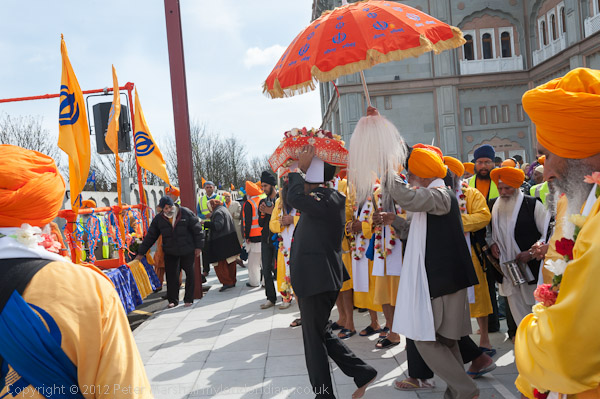
The Guru Granth Sahib is carried out
I went outside and stood in the crowd watching a demonstration of Sikh martial arts, when I noticed a commotion at the other side of the yard, and made my way through a dense crowd to see what was happening. It turned out to be the bringing out of the Guru Granth Sahib, which most of those present had failed to notice, though the crowd was beginning to gather close to the float on which it was to travel. I should have talked to some of the organisers and found out in advance what was likely to happen and when rather than assuming it would happen as I expected.

and is reverently placed inside a replica of the Golden Temple for the procession.
Fortunately I was able to get some good pictures of the ceremony once I was there, and the Gurdwara made a good backdrop for some of the pictures, although the sun caused a few problems.
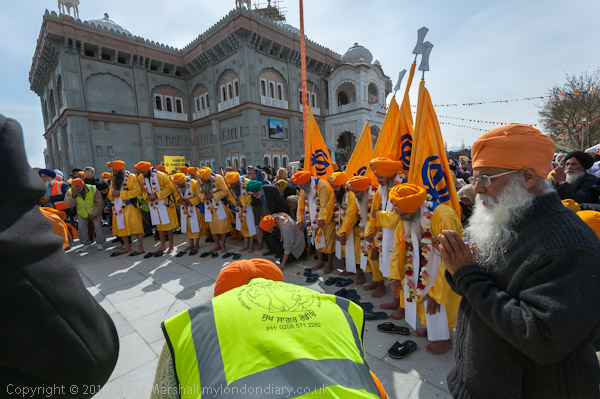
As you can see from the shadows it was only just out of the picture here. For some of the pictures I had to hold up a hand to act as an extra (and more efficient) lens hood.
I was also having problems with the D300, now very much in need of repair or replacement. I’m still dithering about what to do. Two things put me off the D800 – the giant files and the weight of the body. There’s the price as well, but though I certainly couldn’t justify it to my accountant, I could find the money. Unless Nikon come out with something new that suits me better I might end up getting one mainly to use in DX mode with DX lenses.
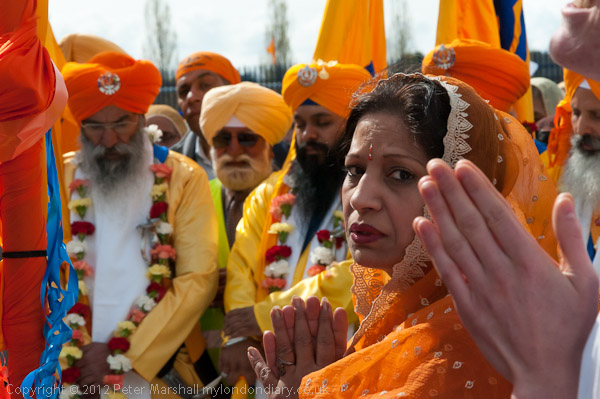
Sometimes the D300 works fine for quite a few frames, but then the mirror will stick up. I’m getting used to dealing with it, and have added “Lock Mirror Up For Cleaning” to my custom menu, and work with this available at the touch of the menu button. Then it’s just press the OK button twice, followed by the shutter release, turn the camera off and on and you are back in business – almost as fast as winding on film in the old days. Except that now it doesn’t always work the first time, and occasionally needs 2 or 3 cycles to bring it down. And while I can sometimes work for 20 or 30 or even more frames without it sticking, sometimes it does it after a single frame. It goes without saying that this is far more likely to happen when things turn interesting and I need to take pictures fast. So probably there are rather more pictures taken on the D700 with the 16-35mm than usual. Though at times I was so close to the action that it was the only possible lens.
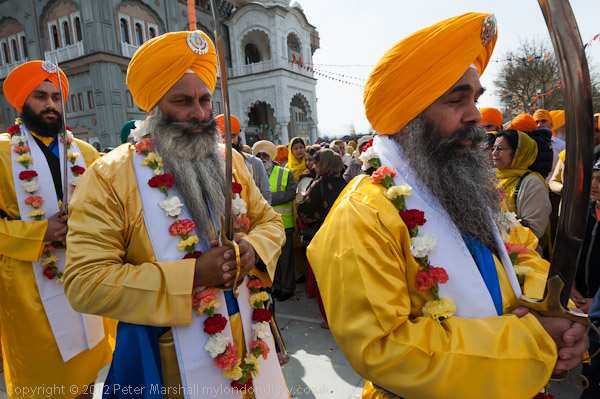
Though perhaps I might otherwise have used the D300 with the 10.5mm fisheye. The procession took a couple of hours to go around town, but there are only so many pictures you can take, and I took advantage of the free food that is on offer at these events. Some delicious minty curried beans, several vegetable samosas, a cup of chai and some fruit juice.
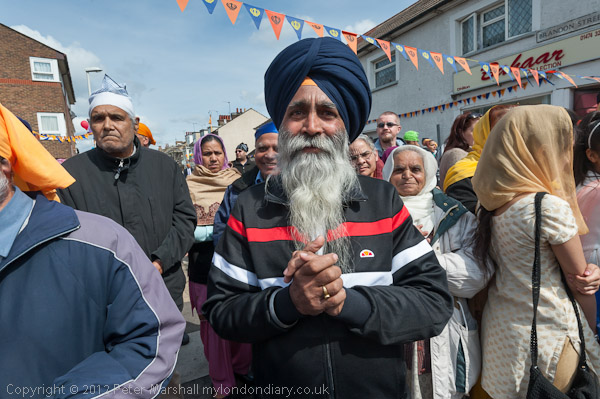
I’d decided earlier when I looked at the route that things might be interesting in the back streets around the much smaller Ravidas Gurdwara which the Vaisakhi procession was to pass. There were a lot of stalls giving away food around there and the procession stopped and there were speeches, but none I could understand.
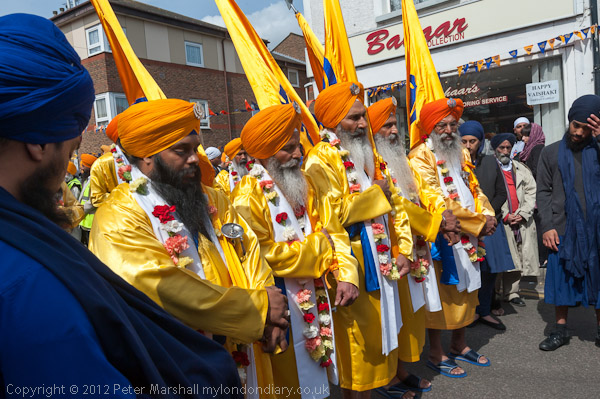
Here I made my way back along the length of the procession filling the narrow street and photographed some of the lorries, coaches and floats coming behind the congregations on foot which follow behind the Nagara drum, the Sikh standards, the Panj Piyare with their raised swords and the Guru Granth Sahib.
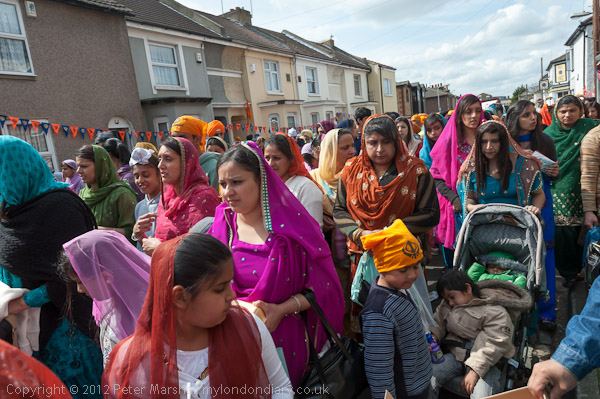
You can see pictures of some of these, and many more in Gravesend Vaisakhi on My London Diary. I left the procession as the end of it passed the civic centre on its way back to the Gurdwara where the celebrations were to continue both on that day and with a service the following day.
________________________________________________________
My London Diary : Buildings of London : River Lea/Lee Valley : London’s Industrial Heritage
All photographs on this and my other sites, unless otherwise stated are by Peter Marshall and are available for reproduction or can be bought as prints.
To order prints or reproduce images
________________________________________________________
Peter, have you thought about buying a used D300? I recently bought one for £650, as good as new with only 2,200 photos taken. It would at least tide you over until Nikon work through their replacements and you can see what you really want.
Thanks for the suggestion. Yes it’s a great bargain at that price. Possibly the repairs to my existing D300 might cost slightly less than that, though I suspect not a lot less. But unless it really packs up completely I’d rather save the money towards something with new possibilities.
How can someone own a D300 and only take 2,200 pictures? I’ve bought a lot of great virtually unused kit second-hand over the years at it’s usually amazed me at how little it has been used. The 10.5mm, 20mm and 60mm macro I have for the Nikon were all ‘previously owned’ by people who seem to have done little but admire them.
Apologies for the rubbish that got added to this post, which I’ve just deleted.
The rubbish linked to http://bcn.uprrp.edu in Puerto Rico and of course had no connection with me.